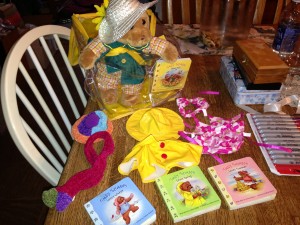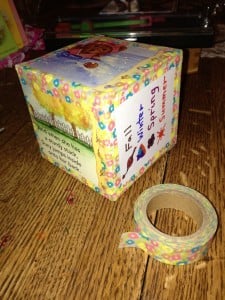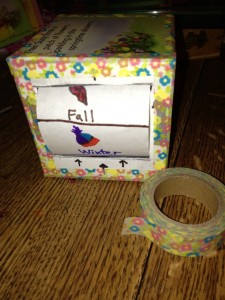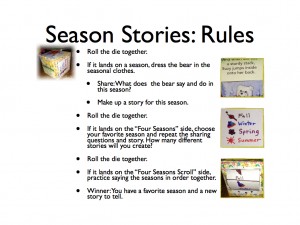Week 2 of #clmooc is #toyhack provided us with a chance to hack something tangible and familiar. Its purpose was to help us stretch out to experience “the make.”
In the Twitter Chat, Joe Dillon reminded us that we are “developing a habit of mind, or an ethos, with students or colleagues, that rules, norms,traditions can be remixed and tinkered with… to develop an ethos to do things for ourselves to share, to make the community better.”
Terry Elliot explained that “Hacking is a stance, literally a place where you stand. And that can be very idiosyncratic.” He also reminded us that “Improvisation is hacking, right. The hacking attitude is already inside us.”
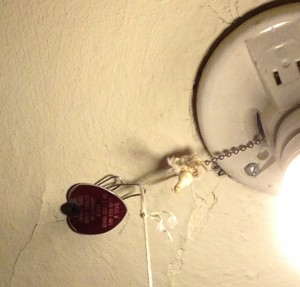 My family are innovators — we constantly hack that which isn’t working the way we need, or hodge podge repairs as needed with the tools at hand. For instance, we live a very old house, and I needed the hall light to stay on for the grandkids. But the string touched the light bulb, so I grabbed what would work — a paper clip and an old cat tag to hold the string away. My husband wasn’t very happy with the looks of it, but it worked.
My family are innovators — we constantly hack that which isn’t working the way we need, or hodge podge repairs as needed with the tools at hand. For instance, we live a very old house, and I needed the hall light to stay on for the grandkids. But the string touched the light bulb, so I grabbed what would work — a paper clip and an old cat tag to hold the string away. My husband wasn’t very happy with the looks of it, but it worked.
So this #toyhack seemed like an easy task, but then the task must fit who you are and your needs, or your community’s needs.
I picked up so many toys, but literally hacking of body parts was not something I could do to change what my grandkids already imagined new characters and stories with. So I enjoyed the stories by Joe Dillon and Karen Young, but I wanted to hack some real thing. I was inspired by conversations about different types of hacks, like Alison Coombs’ masks. Face painting is a favorite past time in this house for grandkids. Then several people mentioned games, and Michael Buist started a community hack for his 10 sticks: Splinters. Since I couldn’t edit the original document, my version is here, a game that could be a cooperative learning discussion during debriefing about the game. I began thinking of a hack for a favorite card game, but then a Teddy Bear caught my eye.
I like how the #clmooc and this #toyhack includes this: to develop an “ethos to do things for ourselves to share, to make the community better.”
So I thought of a way to make this toy, which could travel home with families from school, into one in which parent and child learn together through talking about seasons. I made the toy a storytelling game. It could be hacked more, but I wanted to preserve the purpose: understand the seasons.
Here’s my process and plan:
I hacked the books to use as sides in the die, adding two options: 1) a chance to choose one’s favorite season and 2) a time to practice reciting the seasons in order.
The rules are simple, designed to engage young children in conversation and story about seasons:
As you can see, I stayed true to spreading compassion and to make the world better in both games. And when we teach students, we need to remember their frame of reference and honor the culture and personality that helps the child grow. Diversity makes us stronger.
So, what did I learn?
What does it mean to be a maker? Why make? Why now?
A maker creates from need and neighborhood — what is needed? We need making now to grow our world from individuals consuming to groups considering and creating solutions to group needs.
What happens when makers converge around shared interests and purposes? What opportunities might we seize? What barriers do we face?
I enjoyed all the toy hackers, movie makers, game developers, mask makers. Who knows how each of those processes may help the world. People were commenting on what worked and hacked together. I saw us in the #clmooc community finding the path that fit the person, joining in projects that felt comfortable and challenging. What is important is the coming together, seeing the possible, and trying what we could. For learners, can you see how an example shows them the task is possible, and in all our different “makes,” we demonstrated both the individual and the collective? For learners, we show opportunities and scaffold the challenge to success. The barriers are our own limitations and fears, but by coming together to support each other, we overcome these. That is the power of convergence.
How do we find and build diverse and inspiring networks of people, resources, and places that support our making and learning?
In Twitter and Google Plus I find information, resources, support, and collaboration. I revisited my #f5f from last week (will blog about that next) and found new connections. The people of my connections are diverse in their talents, careers, and purposes, but by exposure to their ideas, I grow more of my own to bring back to my local PLC and community. I think Twitter and Google Plus offer us the true network of connections that cross and build, connect and refresh, backtrack and regroup. We form communities in Google Plus, collaborate in Google Docs and Wikis, and share in all areas. Isn’t the network amazing?
If you ask, the answers arrive. If you answer, your help is thanked. If you share, your share is rebuilt. We are building the networks ourselves, “to make the community better.”

